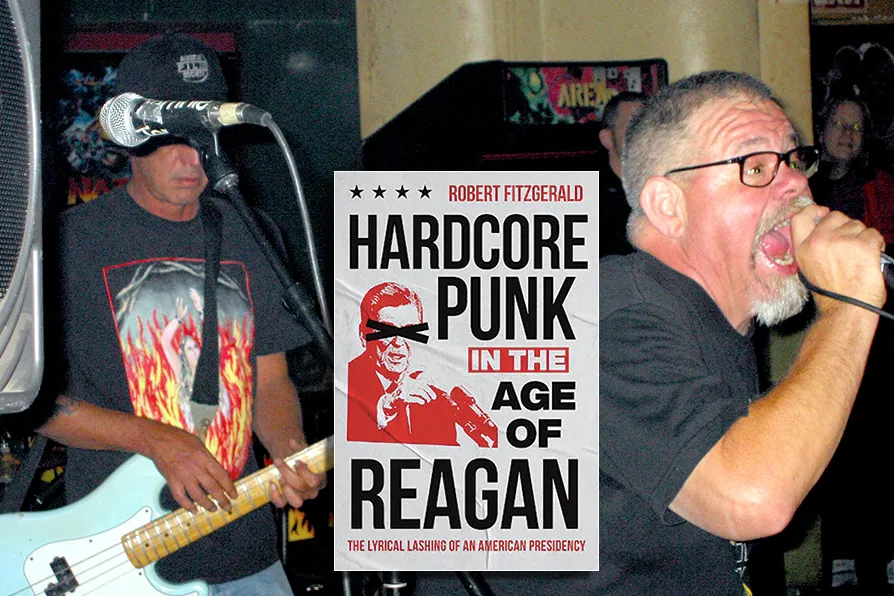MARY CONWAY is disappointed by a production whose design and cartoonish acting overwhelms the close scrutiny of characters
RON JACOBS welcomes a survey of US punk in the era of Reagan, and sees the necessity for some of the same today

 MARXIST LYRICS: Reconfigured Dicks performing in Austin, Texas in 2005 (L to R) Buxf Parrott and Gary Floyd [Pic: pusgums.flickr/CC]
MARXIST LYRICS: Reconfigured Dicks performing in Austin, Texas in 2005 (L to R) Buxf Parrott and Gary Floyd [Pic: pusgums.flickr/CC]
Hardcore Punk in the Age of Reagan: The Lyrical Lashing of an American Presidency
Robert Fitzgerald, University of North Carolina Press, £31
I WAS never a huge fan of hardcore punk music. That being said, one band from Texas did get my notice, but not until they moved to the Bay Area. They called themselves The Dicks and it was their song called Anti-Klan that caught my attention when I heard it blasting from a window on the corner of Haight Street and Masonic Street — right above Uganda Liquors. The singer Gary Floyd makes the connection between the Klan and the cops crystal clear.
Author Robert Fitzgerald describes The Dicks lyrical content like this in his new book Hardcore Punk in the Age of Reagan: The Lyrical Lashing of an American Presidency: “They made targeting Nazis, the Klan and racist police central to their songwriting throughout their career.” Any band that did that had my attention.
Fitzgerald, who is described as the assistant principal of the Thomas Metcalf Laboratory School in his bio on the book’s back cover, is a lifelong fan of punk. His book discusses a plethora of punk bands and musicians that came and went during the year Ronald Reagan squatted in the White House, making America great again the first time around.
Although at times little more than a catalog of bands and their anti-establishment lyrics, when considered in its entirety Hardcore Punk in the Age of Reagan becomes a unique and important history of the hard turn to the right in the United States of the 1980s. More importantly, at least in my mind, is that it is also a history of a rebellion against that turn by many of the nation’s youth; a rebellion founded in and defined by its music and the subculture that developed around it.
Fitzgerald divides the book into chapters that encompass the major political foci of the decade. In doing this, he describes the central elements of the Reagan counterrevolution: nuclear proliferation, the US counterinsurgency in Central America, the resurgence of the racist right, the brutality of the police, the rise of the religious right and the accompanying heterosexism and homophobia, and the intentional impoverishment of America’s already marginalised populations.
In his discussion, Fitzgerald bounces the reader around the country, introducing bands and their music; bands and their local scenes. He looks at the lyrics and remarks on their delivery by the bands that wrote them. Reflecting on the lyrics, he points out their power and their inconsistencies, especially those that comment on the innate racism white residents of the US often (if not always) seem to hold.
In the chapter titled Police Story which is about police brutality, police overreach and police power, the author points out that punks were calling out and going after the cops in their songs years before hip hop groups like NWA and Body Count. Of course, it was the hip hop artists who were attacked by the media and the police union (who were most likely feeding the media its stories). In part, this was because the reach of the rap songs was much greater than that experienced by the hardcore bands.
However, it’s a fairly obvious statement to make that it was the hip hop genre’s identity as the music of black people that truly brought the wrath of the police down on them. It’s not that the cops didn’t come down on the punk bands and their fans, they just came down harder on the rap musicians and their scene. After all, US cops have plenty of practice in going after African-Americans.
Hardcore Punk in the Age of Reagan is a great introduction to the world of hardcore punk in the 1980s. It is also a less-than-gentle reminder that Ronald Reagan was not much different than Donald Trump is today — a less loutish Trump, if you will. I heartily recommend reading it with a device that streams music within reach. That way, if there’s a song you don’t know or aren’t sure you remember, chances are you can find it in the internet ether and turn it up.
LOUD, of course.
Ron Jacobs is the author of several books, including Daydream Sunset: Sixties Counterculture in the Seventies published by CounterPunch Books. His latest book, titled Nowhere Land: Journeys Through a Broken Nation, is now available. He lives in Vermont. He can be reached at: ronj1955@gmail.com

New releases from The Dreaming Spires, Bruce Springsteen, and Chet Baker

April 9 1928 – July 26 2025

TOM STONE checks the political coordinates of a festival where the pleasures of nostalgia were (sometimes) harnessed to a new message











